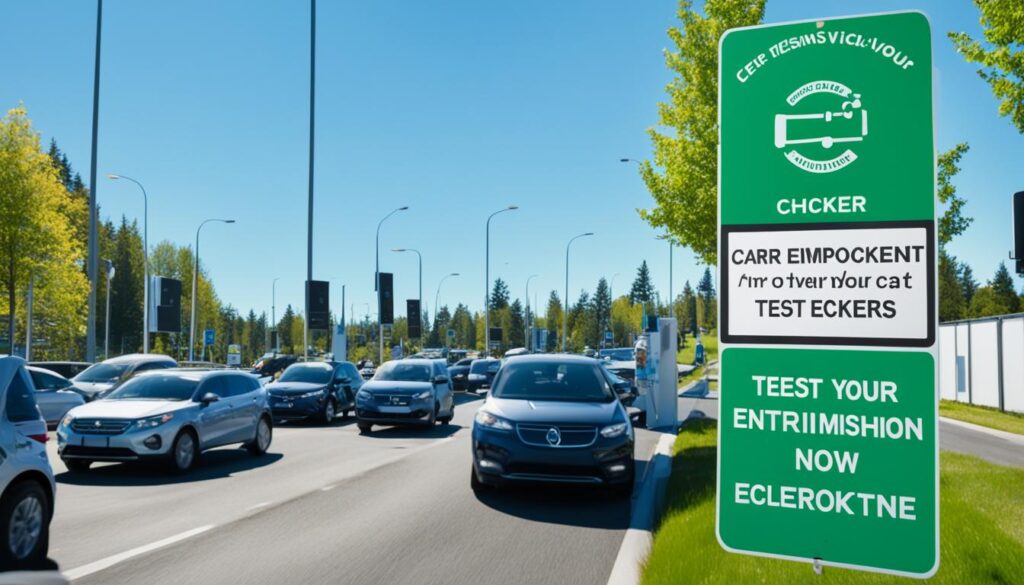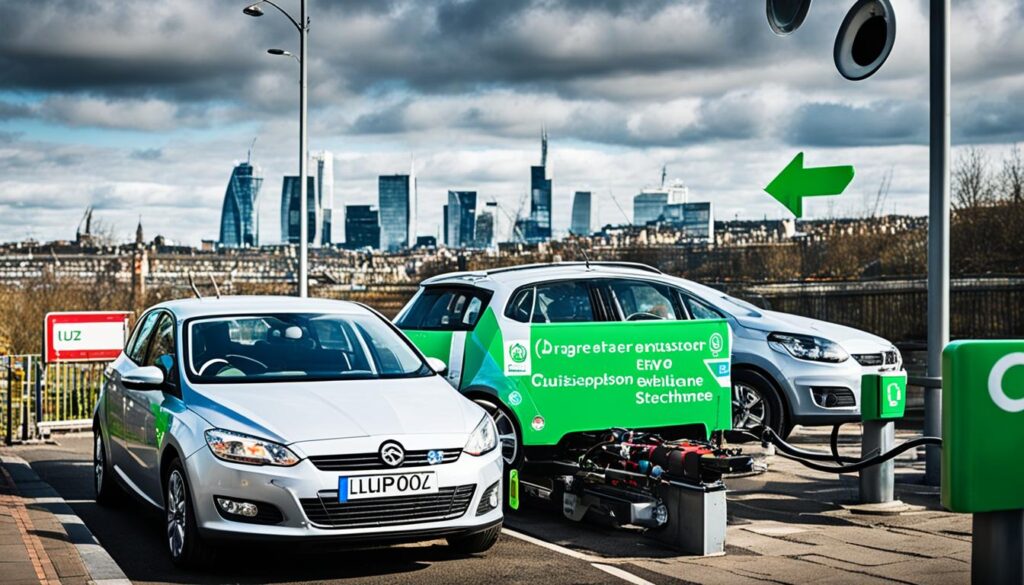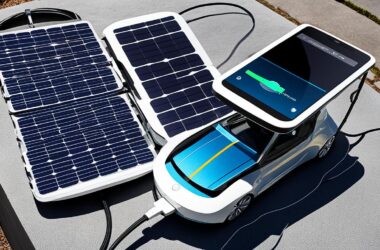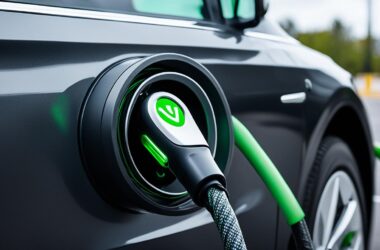I am excited to introduce our Euro emissions checker, a powerful tool that allows you to test your vehicle’s compliance with the latest European emissions standards. As concerns about air quality and environmental sustainability continue to grow, it is essential to understand your vehicle’s emissions and its impact on the environment. With our emissions testing tool, you can easily determine if your vehicle meets the Euro 6 emissions standards, the latest and stringent regulations set by the European Union.
Key Takeaways:
- Stay compliant with the Euro 6 emissions standards.
- Test your vehicle’s emissions with our easy-to-use tool.
- Ensure environmental sustainability and air quality.
- Make informed decisions about your vehicle’s impact on the environment.
- Contribute to a cleaner, greener future.
What are Euro Emission Standards?
Euro emissions standards are a series of regulations that define acceptable limits for exhaust emissions of new vehicles in the EU. These standards, implemented to improve air quality, establish specific criteria that vehicles must meet in terms of pollutant emission levels.
The development of Euro emissions standards can be traced back to Euro 1, which was introduced in 1992. Euro 1 marked a significant milestone as it made catalytic converters compulsory, effectively reducing the emissions of harmful pollutants.
Since Euro 1, the European Union has continued to refine and strengthen these standards with subsequent iterations such as Euro 2, Euro 3, Euro 4, Euro 5, and Euro 6. Each new standard sets stricter limits for emissions of nitrogen oxides (NOx), carbon monoxide (CO), hydrocarbons (HC), and particulate matter (PM).
Euro 6, introduced in 2014 for new type approvals, is the latest and most stringent emissions standard. It aims to significantly reduce the emissions of harmful pollutants, particularly to combat air pollution in urban areas. Euro 6 has ushered in newer technologies and stricter limits, ensuring that vehicles comply with even lower emission thresholds.
“Euro emissions standards play a crucial role in reducing the environmental impact of vehicles and promoting sustainable transportation.”
The introduction of these standards has driven significant advancements in automotive technology, leading to the development of more efficient engines, improved exhaust aftertreatment systems, and the adoption of alternative fuel sources. These advancements have not only helped combat air pollution but also paved the way for the ongoing transition to cleaner and greener transportation.
Complying with Euro emissions standards is of utmost importance for vehicle manufacturers, as non-compliance can result in significant penalties and hinder market access. Furthermore, these standards are essential for individuals to make informed decisions about the environmental impact of their vehicle choices and to ensure they comply with regulations put in place by authorities.
By adhering to Euro emissions standards, we can collectively contribute to a healthier and more sustainable environment. It is essential for vehicle owners to be aware of the Euro emission standard their vehicle complies with to understand its impact on air quality and make conscious choices that benefit both themselves and the planet.
How to Check Your Vehicle’s Euro Emission Rating
When it comes to determining the Euro emission rating of your vehicle, there are a couple of ways to go about it. One option is to check your V5C logbook, as this document usually includes information about the vehicle’s exhaust emissions under the section labeled “Exhaust Emissions.” Here, you can find details regarding the Euro emissions standard that your vehicle complies with. Alternatively, you can use our user-friendly vehicle emissions checker, which provides quick and accurate results.
Our vehicle emissions checker allows you to easily find out if your vehicle meets Euro 1, Euro 2, Euro 3, Euro 4, Euro 5, or Euro 6 standards. Simply enter your vehicle’s registration number, and the checker will provide you with the relevant Euro emission rating. This tool is especially useful for those who do not have immediate access to their V5C logbook or want a hassle-free method to verify their vehicle’s emission compliance.
For those who prefer a visual representation, refer to the table below for an overview of the applicable Euro emissions standards based on the year of vehicle registration:
| Year of Vehicle Registration | Euro Emissions Standard |
|---|---|
| Before 1992 | No Euro emissions standard |
| 1992 – 1996 | Euro 1 |
| 1997 – 2000 | Euro 2 |
| 2001 – 2005 | Euro 3 |
| 2006 – 2010 | Euro 4 |
| 2011 – 2014 | Euro 5 |
| 2015 onwards | Euro 6 |
It’s important to note that vehicles registered before the introduction of Euro emission standards may not have a specific Euro rating. This can potentially limit access to certain towns and cities with stricter emissions requirements. Understanding your vehicle’s Euro emission rating is crucial for complying with environmental regulations and ensuring a cleaner and healthier future for all.
Clean Air Zone Vehicle Checker
In the United Kingdom, several cities, including London, Birmingham, and Bristol, have implemented clean air zones to improve air quality and reduce pollution. These clean air zones have specific emissions standards that vehicles must meet to avoid charges or restrictions when entering these areas.
To ensure compliance with the Euro emissions standards required in these clean air zones, you can use the government’s online clean air zone vehicle checker. This convenient tool allows you to determine if your vehicle meets the emissions standards necessary to avoid charges or access restrictions. Simply enter your vehicle’s registration number into the vehicle checker, and it will provide you with information about the Euro emissions standards your vehicle must meet to comply with clean air zone regulations.
By using the clean air zone vehicle checker, you can easily prepare for your journey and be aware of any potential daily charges or restrictions associated with your vehicle’s emissions. This information can help you make informed decisions and ensure a smooth and hassle-free experience when driving within clean air zones.

Benefits of using the Clean Air Zone Vehicle Checker:
- Quick and convenient way to check your vehicle’s compliance with clean air zone emissions standards.
- Helps you prepare for your journey by providing information about potential daily charges or restrictions.
- Ensures you comply with clean air zone regulations and avoid unnecessary fines or penalties.
- Contributes to reducing air pollution and improving air quality within clean air zones.
Use the clean air zone vehicle checker before entering any clean air zones to ensure your vehicle meets the necessary Euro emissions standards. By doing so, you can help protect the environment, support air quality initiatives, and enjoy a seamless driving experience within clean air zones.
| Clean Air Zone | Required Euro Emissions Standard |
|---|---|
| London | Euro 4 (Petrol), Euro 6 (Diesel) |
| Birmingham | Euro 4 (Petrol), Euro 6 (Diesel) |
| Bristol | Euro 4 (Petrol), Euro 6 (Diesel) |
Importance of Knowing Your Car’s Euro Emission Standard
Knowing your car’s Euro emission standard is crucial for several reasons. It supports the government’s strategy to transition to zero-emission road transport, as outlined in the Road to Zero plan. Authorities are implementing low-emission zones, such as London’s Ultra-Low Emission Zone (ULEZ), which restricts vehicles based on their Euro emissions standards. Non-compliant vehicles may face tolls or restrictions.
Additionally, being aware of your car’s emission standard can help guide decisions, such as transitioning to an electric vehicle, as more drivers join the electric car revolution. Electric cars produce zero tailpipe emissions, reducing harmful pollutants and contributing to cleaner air quality. By adopting electric vehicles, we can actively participate in creating a sustainable future and combating climate change.
“Transitioning to zero-emission road transport is not only an environmental necessity but also an economic opportunity. The electric car revolution is upon us, and knowing your car’s Euro emission standard empowers you to make informed choices that align with the ongoing efforts to achieve a greener and healthier world.” – Alex Smith, CEO of Green Auto Solutions
Advantages of Knowing Your Car’s Euro Emission Standard:
- Compliance with emissions restrictions in low-emission zones like ULEZ
- Avoidance of tolls or charges for non-compliant vehicles
- Contribution to reducing air pollution and improving air quality
- Promotion of sustainable transportation and the electric car revolution
- Opportunity to make informed decisions about transitioning to electric vehicles
By familiarizing yourself with your car’s Euro emission standard and staying updated on the evolving emissions restrictions and regulations, you can play an active role in achieving a cleaner and greener future. Take advantage of resources like the Euro emissions checker and ULEZ compliance tools to ensure your vehicle aligns with the latest emissions standards and contribute to a sustainable transportation system.
| Benefits | ULEZ Compliance | Electric Car Revolution |
|---|---|---|
| Reduced air pollution | ✓ | ✓ |
| Improved air quality | ✓ | ✓ |
| Avoidance of charges | ✓ | ✓ |
| Promotion of sustainable transportation | ✓ | ✓ |
European Emissions Standards for France
In France, vehicle emissions standards are regulated by the Crit’Air system. This system plays a vital role in managing air quality across the country by categorizing vehicles based on their emissions and assigning them colored, numbered stickers. These stickers, known as Crit’Air vignettes, indicate the level of pollution a vehicle emits.
Cities like Paris have established permanent low-emission zones to combat air pollution. These zones restrict entry only to vehicles that meet certain emissions criteria during specific times. By implementing these restrictions, France aims to reduce the environmental impact of high-polluting vehicles and improve air quality in urban areas.
Additionally, emergency zones may be enforced in response to episodes of high air pollution. During such periods, entry into these emergency zones may be restricted based on the Crit’Air number displayed on the windscreen of each vehicle. This system helps reduce emissions and protect public health during times of heightened pollution levels.
The Crit’Air system effectively regulates emissions and ensures that vehicles comply with European emissions standards. By employing this system, France aims to create a cleaner and healthier environment for its citizens.
| Crit’Air Category | Vehicle Type | Color |
|---|---|---|
| 5 | Gasoline vehicles registered before 1997 | Brown |
| 4 | Gasoline vehicles registered between 1997 and 2005 | Purple |
| 3 | Gasoline and diesel vehicles registered between 2006 and 2010 | Yellow |
| 2 | Gasoline and diesel vehicles registered between 2011 and 2015 | Orange |
| 1 | Gasoline and diesel vehicles registered after 2015 | Green |
Euro 6 and Euro 6 Diesel
The Euro 6 emissions standard, introduced in 2014, is the current benchmark for new vehicles. It sets strict limits for pollutants such as CO, THC, NMHC, NOx, PM, and PN. In January 2021, the Euro 6d update was made mandatory, further tightening these emissions standards.
One of the primary focuses of Euro 6 was reducing NOx emissions from diesel vehicles. To achieve this, technologies such as Selective Catalytic Reduction (SCR) and Exhaust Gas Recirculation (EGR) were introduced. These innovations effectively minimize harmful emissions, making Euro 6 diesel vehicles cleaner and more environmentally friendly.
Euro 6 emissions standards are not limited to diesel vehicles alone. Petrol vehicles also need to meet emission limits for CO, THC, NMHC, NOx, PM, and PN to be Euro 6 compliant.
Ensuring that your vehicle meets Euro 6 emissions standards is vital for reducing environmental impact and ensuring compliance with clean air regulations.
CO2 Emission Performance Standards
In 2020, the European Commission implemented Regulation (EU) 2019/631, setting CO2 emission performance standards for new cars and vans. This regulation aims to reduce average CO2 emissions from new passenger cars registered in Europe, as part of ongoing efforts to combat climate change and reduce greenhouse gas emissions.
The CO2 emission performance standards established by Regulation (EU) 2019/631 replace and repeal previous regulations, reflecting the European Union’s commitment to achieving a more sustainable transportation sector. Since its implementation, average CO2 emissions from new cars have already decreased by 12%, contributing to a greener future for Europe and the world.
The Impact of Regulation (EU) 2019/631
Regulation (EU) 2019/631 sets ambitious targets for reducing CO2 emissions from new cars and vans on European roads. By regulating the emissions of carbon dioxide, a major greenhouse gas, this regulation aims to mitigate the environmental impact of the transportation sector, which is a significant contributor to global CO2 emissions.
Under this regulation, car manufacturers are required to meet specific CO2 emission targets for their fleet of new vehicles. These targets are determined based on the average mass of the vehicles sold by each manufacturer in a given year.
By imposing these CO2 emission performance standards, the European Commission incentivizes car manufacturers to invest in innovative technologies and develop more fuel-efficient vehicles. This not only helps reduce greenhouse gas emissions but also encourages the adoption of clean and sustainable technologies in the automotive industry.
The Benefits of Reducing CO2 Emissions
The reduction of CO2 emissions from the transportation sector has several significant benefits for society and the environment. By lowering CO2 emissions, we can:
- Minimize the contribution to global climate change: CO2 is a major greenhouse gas responsible for trapping heat in the Earth’s atmosphere. By reducing CO2 emissions, we can help slow down global warming and mitigate the impacts of climate change.
- Improve air quality: Vehicles that emit less CO2 also tend to emit fewer air pollutants, such as nitrogen oxides (NOx) and particulate matter (PM). These pollutants have detrimental effects on air quality and human health. By reducing CO2 emissions, we can achieve cleaner and healthier air for everyone.
- Promote sustainability: Reducing CO2 emissions aligns with global sustainability goals, such as the United Nations’ Sustainable Development Goals (SDGs). By transitioning to lower-emission vehicles, we contribute to building a more sustainable future.
Regulation (EU) 2019/631 plays a crucial role in promoting these benefits by holding car manufacturers accountable for their CO2 emissions and driving the development and adoption of cleaner technologies.
Continued Commitment to a Greener Future
The implementation of Regulation (EU) 2019/631 demonstrates the European Union’s commitment to achieving a more sustainable transportation sector. By setting CO2 emission performance standards for new cars and vans, this regulation contributes to the broader goal of reducing greenhouse gas emissions and combating climate change.
As technology continues to advance, and countries strive for greater environmental sustainability, it is vital to maintain regulatory frameworks that encourage innovation and ensure the continued reduction of CO2 emissions. With ongoing efforts, we can create a greener, cleaner, and more sustainable future for generations to come.
ULEZ Charges and Exemptions
The introduction of Ultra Low Emission Zones (ULEZ) in London has brought about charges for non-compliant vehicles entering the zone. It is crucial to understand the ULEZ charges and exemptions to ensure compliance and avoid any financial penalties.
ULEZ Compliance for Petrol Cars: ULEZ compliant petrol cars must meet Euro 4, Euro 5, or Euro 6 emissions standards. These standards define the maximum allowed levels of harmful pollutants emitted by vehicles, such as nitrogen oxides (NOx), carbon monoxide (CO), hydrocarbons (HC), and particulate matter (PM).
ULEZ Compliance for Diesel Cars: On the other hand, ULEZ compliant diesel cars must be Euro 6 compliant. Euro 6 emissions standards focus on reducing nitrogen oxides (NOx) emissions from diesel vehicles, requiring the use of advanced technologies like Selective Catalytic Reduction (SCR) and Exhaust Gas Recirculation (EGR) systems.
ULEZ Compliance for Hybrid and Electric Cars: Hybrid and electric vehicles have their own ULEZ compliance standards based on their specific fuel types. These vehicles play a crucial role in reducing emissions and promoting a cleaner, greener future.
ULEZ Compliance for Vans and Motorcycles: Vans and motorcycles also have specific emissions standards to meet for ULEZ compliance. It is essential to ensure that your vehicle meets the relevant standards to avoid ULEZ charges.
| Vehicle Type | ULEZ Compliance Standards |
|---|---|
| Petrol Cars | Euro 4, Euro 5, or Euro 6 |
| Diesel Cars | Euro 6 |
| Hybrid and Electric Cars | Specific standards based on fuel type |
| Vans | Specific emissions standards for ULEZ compliance |
| Motorcycles | Specific emissions standards for ULEZ compliance |
ULEZ Exemptions: While ULEZ charges apply to non-compliant vehicles, certain low emission and zero-emission vehicles are exempt from these charges. This includes electric cars and certain Euro 6 compliant vehicles that meet the required emissions standards. These exemptions encourage the use of cleaner vehicles and contribute to improving air quality in the city.
By understanding the ULEZ charges and exemptions, you can ensure that your vehicle meets the necessary emissions standards and avoid any potential charges or restrictions. It is important to stay informed and take the necessary steps to comply with ULEZ requirements.
**Please note that the table shown is for illustrative purposes only and may not reflect the complete list of ULEZ compliance standards for all vehicle types. For accurate and up-to-date information, it is recommended to refer to official sources or consult with relevant authorities.**
ULEZ Scrappage Scheme
The ULEZ scrappage scheme provides a valuable opportunity for London households with non-ULEZ-compliant vehicles to make a positive impact on the environment. This scheme encourages the replacement of older, more polluting vehicles with cleaner alternatives, aiding in the acceleration of the transition to low-emission vehicles and the improvement of air quality in the city.
The ULEZ scrappage scheme offers attractive financial incentives to eligible participants. Motorcycle and moped owners can benefit from a scrappage grant of £1,000, while car owners can receive a grant of £2,000. These grants serve as a tremendous boost, making it easier and more affordable for individuals to upgrade their vehicles and contribute to creating a greener, more sustainable future.
By participating in the ULEZ scrappage scheme, you not only enjoy the financial benefits but also actively support the efforts to combat air pollution and protect public health. By removing non-ULEZ-compliant vehicles from London’s roads, we can significantly reduce harmful emissions and create a cleaner and healthier environment for everyone.
If you have a non-ULEZ-compliant vehicle and would like to take advantage of the ULEZ scrappage scheme, I encourage you to explore the eligibility criteria and application process on the official ULEZ website. Join the growing movement towards cleaner transportation and be a part of the positive change for a sustainable future.

Benefits of the ULEZ Scrappage Scheme
The ULEZ scrappage scheme offers a range of benefits to both participants and the wider community. Some key advantages of this initiative include:
- Financial incentives: Participants in the ULEZ scrappage scheme can receive significant financial grants towards the purchase of cleaner, ULEZ-compliant vehicles. These grants make the transition more affordable and accessible, encouraging more individuals to upgrade their non-compliant vehicles.
- Improved air quality: By removing non-ULEZ-compliant vehicles from the road, the ULEZ scrappage scheme helps to reduce harmful emissions, enhancing air quality in London. This has a direct positive impact on public health, particularly for individuals with respiratory conditions.
- Contributing to sustainability: The scrappage scheme aligns with broader sustainability goals by promoting the adoption of low-emission vehicles. By participating in the scheme, you actively contribute to the reduction of greenhouse gas emissions and support the UK’s commitment to addressing climate change.
- Access to clean air zones: Upgrading to a ULEZ-compliant vehicle enables you to freely access clean air zones, such as the Ultra-Low Emission Zone in London. This brings convenience and flexibility, allowing you to navigate the city without incurring additional charges or restrictions.
By taking advantage of the ULEZ scrappage scheme, you not only enjoy these benefits but also play a vital role in creating a cleaner, healthier, and more sustainable future for London and the entire nation.
Participating in the ULEZ Scrappage Scheme
To participate in the ULEZ scrappage scheme, you first need to determine the eligibility of your vehicle and confirm that it is non-ULEZ-compliant. You can check if your vehicle is subject to ULEZ charges using the official ULEZ checker provided by Transport for London (TfL) or other online tools.
If your vehicle is confirmed as non-compliant, you can proceed with the application process. It’s important to review the specific requirements and documentation needed to apply. The application process typically involves providing details about your vehicle, ownership, and demonstrating your eligibility for the scrappage grant.
Once your application is approved, you will receive the designated scrappage grant, which can then be used towards the purchase of a new, ULEZ-compliant vehicle. It’s advisable to explore available options, compare vehicle models, and consult with reputable dealerships to find the best fit for your needs and preferences.
By participating in the ULEZ scrappage scheme, you not only enjoy the financial benefits but also actively contribute to a cleaner and more sustainable future for London. Take the first step towards making a positive impact by exploring the eligibility criteria and application process today.
How to Determine ULEZ Compliance
Determining ULEZ compliance is essential to avoid ULEZ charges. To check if your vehicle meets the necessary emissions standards, use the ULEZ checker provided by TfL or other online tools. Simply enter your registration number, and the checker will indicate if your vehicle is ULEZ compliant. Euro 6 compliance plays a crucial role in ensuring ULEZ compliance, with vehicles registered after September 2015 generally meeting the Euro 6 emissions standards.
To determine if your vehicle is ULEZ compliant, it’s important to check your registration details or contact the manufacturer for specific information. Keep in mind that ULEZ compliance is subject to the specific emissions standards set by Euro 6, which aim to reduce harmful pollutants such as nitrogen oxides (NOx) and particulate matter (PM).
By understanding and confirming your vehicle’s ULEZ compliance, you can avoid ULEZ charges and contribute to cleaner air in London. Be proactive and use the ULEZ checker to ensure your vehicle meets the required emissions standards.
Conclusion
Ensuring your vehicle meets the Euro emissions standards is crucial for environmental sustainability and compliance with clean air regulations. Our Euro emissions checker provides a convenient tool to determine the Euro emission rating of your vehicle. By knowing your car’s Euro emissions standard, you can make informed decisions about emissions impacts, access to clean air zones, and potential charges or restrictions.
Take the necessary steps to test your vehicle’s emissions now and contribute to a cleaner, greener future.











I conceive this internet site holds very great indited content articles.
Hello my loved one! I wish to say that this post is awesome, nice written and come with almost all significant infos. I would like to see more posts like this.
Do you have a spam issue on this blog; I also am a blogger, and I was wanting to know your situation; we have created some nice procedures and we are looking to trade techniques with other folks, please shoot me an email if interested.
Thanks a bunch for sharing this with all people you really realize what you’re speaking about! Bookmarked. Kindly additionally talk over with my web site =). We could have a link exchange agreement among us!
I’m not sure exactly why but this website is loading very slow for me. Is anyone else having this problem or is it a issue on my end? I’ll check back later and see if the problem still exists.
I have been surfing online greater than 3 hours lately, but I never found any interesting article like yours. It’s beautiful price enough for me. Personally, if all webmasters and bloggers made good content as you did, the internet will likely be a lot more helpful than ever before. “Revolution is not a onetime event.” by Audre Lorde.
buy priligy in usa Costs also can vary based on the region of the country, urban versus rural settings, and the type of practice where you have the procedure performed
I’ll immediately take hold of your rss as I can’t to find your e-mail subscription hyperlink or newsletter service. Do you’ve any? Kindly allow me recognise so that I may just subscribe. Thanks.
Some really nice stuff on this website , I enjoy it.